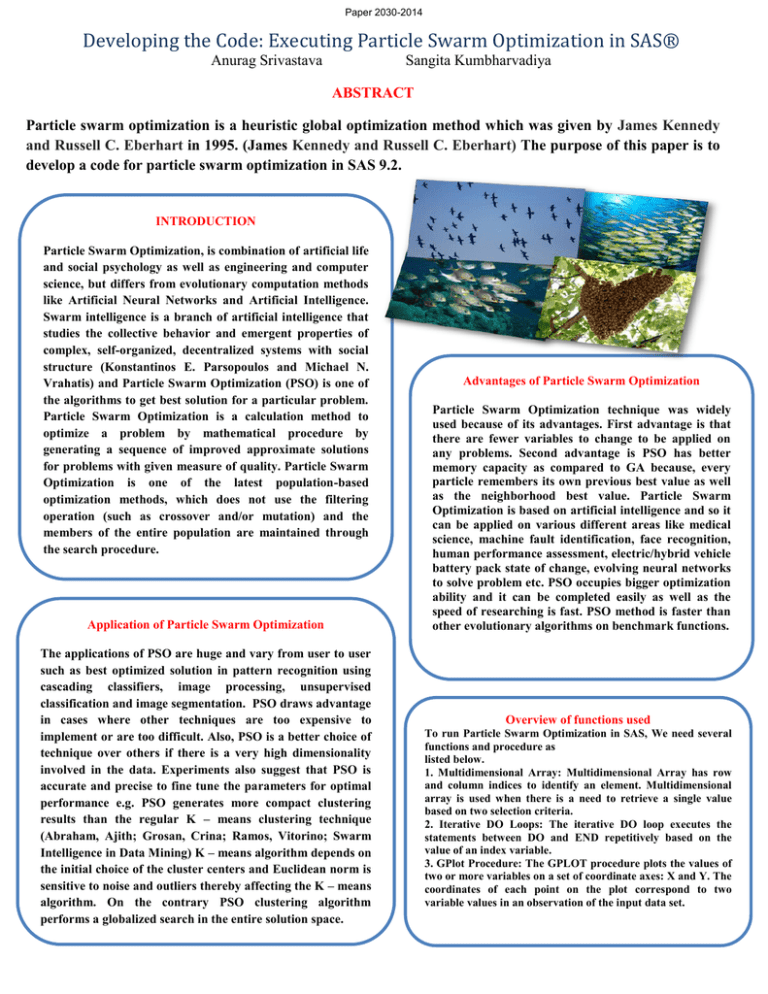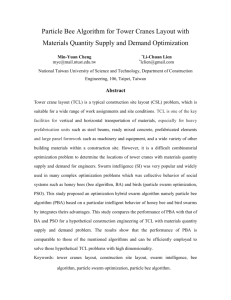Developing the Code: Executing Particle Swarm Optimization in SAS®
advertisement

Paper 2030-2014
Developing the Code: Executing Particle Swarm Optimization in SAS®
Anurag Srivastava
Sangita Kumbharvadiya
ABSTRACT
Particle swarm optimization is a heuristic global optimization method which was given by James Kennedy
and Russell C. Eberhart in 1995. (James Kennedy and Russell C. Eberhart) The purpose of this paper is to
develop a code for particle swarm optimization in SAS 9.2.
INTRODUCTION
Particle Swarm Optimization, is combination of artificial life
and social psychology as well as engineering and computer
science, but differs from evolutionary computation methods
like Artificial Neural Networks and Artificial Intelligence.
Swarm intelligence is a branch of artificial intelligence that
studies the collective behavior and emergent properties of
complex, self-organized, decentralized systems with social
structure (Konstantinos E. Parsopoulos and Michael N.
Vrahatis) and Particle Swarm Optimization (PSO) is one of
the algorithms to get best solution for a particular problem.
Particle Swarm Optimization is a calculation method to
optimize a problem by mathematical procedure by
generating a sequence of improved approximate solutions
for problems with given measure of quality. Particle Swarm
Optimization is one of the latest population-based
optimization methods, which does not use the filtering
operation (such as crossover and/or mutation) and the
members of the entire population are maintained through
the search procedure.
Application of Particle Swarm Optimization
The applications of PSO are huge and vary from user to user
such as best optimized solution in pattern recognition using
cascading classifiers, image processing, unsupervised
classification and image segmentation. PSO draws advantage
in cases where other techniques are too expensive to
implement or are too difficult. Also, PSO is a better choice of
technique over others if there is a very high dimensionality
involved in the data. Experiments also suggest that PSO is
accurate and precise to fine tune the parameters for optimal
performance e.g. PSO generates more compact clustering
results than the regular K – means clustering technique
(Abraham, Ajith; Grosan, Crina; Ramos, Vitorino; Swarm
Intelligence in Data Mining) K – means algorithm depends on
the initial choice of the cluster centers and Euclidean norm is
sensitive to noise and outliers thereby affecting the K – means
algorithm. On the contrary PSO clustering algorithm
performs a globalized search in the entire solution space.
Advantages of Particle Swarm Optimization
Particle Swarm Optimization technique was widely
used because of its advantages. First advantage is that
there are fewer variables to change to be applied on
any problems. Second advantage is PSO has better
memory capacity as compared to GA because, every
particle remembers its own previous best value as well
as the neighborhood best value. Particle Swarm
Optimization is based on artificial intelligence and so it
can be applied on various different areas like medical
science, machine fault identification, face recognition,
human performance assessment, electric/hybrid vehicle
battery pack state of change, evolving neural networks
to solve problem etc. PSO occupies bigger optimization
ability and it can be completed easily as well as the
speed of researching is fast. PSO method is faster than
other evolutionary algorithms on benchmark functions.
Overview of functions used
To run Particle Swarm Optimization in SAS, We need several
functions and procedure as
listed below.
1. Multidimensional Array: Multidimensional Array has row
and column indices to identify an element. Multidimensional
array is used when there is a need to retrieve a single value
based on two selection criteria.
2. Iterative DO Loops: The iterative DO loop executes the
statements between DO and END repetitively based on the
value of an index variable.
3. GPlot Procedure: The GPLOT procedure plots the values of
two or more variables on a set of coordinate axes: X and Y. The
coordinates of each point on the plot correspond to two
variable values in an observation of the input data set.
PSO Algorithm
The PSO Code
/* Set the graphics environment */
goptions reset=all border cback=white htitle=12pt;
data pfinal;
iFUCNNO=-1;
iPOPSIZE = 40;
iDIMENSIONS = 2;
fINITWT = 0.9;
fMAXVEL = 10;
nMAXITER =2000;
fMaxPos = 100;
fERRCUTOFF =0.00001;
iLOCAL = 0;
sOutfile = "psoutfil.txt";
iXcoord1=1;
iYcoord1=1;
iZcoord1=1;
nIter=0;
array fPosi[2,40]iPOPSIZE1-iPOPSIZE40 iDIMENSIONS1
iDIMENSIONS40;
array fTempPos[2,40]iPOPSIZE1-iPOPSIZE40
iDIMENSIONS1-iDIMENSIONS40;
array fVel[2,40]iPOPSIZE1-iPOPSIZE40
iDIMENSIONS1-iDIMENSIONS40;
array fBestPos[2,40]iPOPSIZE1-iPOPSIZE40
iDIMENSIONS1-iDIMENSIONS40;
array fDumVel[2]iDIMENSIONS1-iDIMENSIONS2;
array fErrVal[2]iPOPSIZE1-iPOPSIZE2;
array fPbestVal[40]iPOPSIZE1-iPOPSIZE40;
array iBetter[40]iPOPSIZE1-iPOPSIZE40;
array iNeighbor[40]iHOODINDEX1-iHOODINDEX40;
If iLOCAL > 0 Then iHOODSIZE = Int(iLOCAL / 2) * 2;
Else iHOODSIZE = iPOPSIZE;
iPopindex=1;
iDimindex=1;
Do i=1 to dim1(fPosi);
Do j=1 to dim2(fPosi);
fPosi(iPopindex,iDIMENSIONS)=rand('EXPO')*fMaxPos;
fBestPos(iPopindex,iDIMENSIONS)=fPosi(iPopindex,iDIM
ENSIONS);
fVel(iPopindex,iDIMENSIONS)=rand('EXPO')*fMAXVEL
;
If rand('EXPO') > 0.5 Then
fPosi(iPopindex,iDIMENSIONS)=fPosi(iPopindex,iDIMENSIONS);
If rand('EXPO')> 0.5 Then
fVel(iPopindex,iDIMENSIONS)=fVel(iPopindex,iDIMENSIONS);
Output;
end;
output;
end ;
fInerWt = ((fINITWT - 0.4) * (nMAXITER - nIter) /
nMAXITER) + 0.4;
do i=1 to dim1(fPosi);
do j=1 to dim2(fPosi);
fDumVel(iDimindex) = fVel(iPopindex, iDimindex);
output;
end;
iBetter(iPopindex) = 0;
fErrVal(iPopindex) = 0;/*sphare function started*/
do j = 1 To dim(fPosi);
fErrValDim = (fPosi(iPopindex, iDimindex)) ** 2;
fErrVal(iPopindex) = fErrVal(iPopindex) +
fErrValDim;
output;
end;/*end of the sphare function*/
if nIter = 1 Then fPbestVal(iPopindex) =
fErrVal(iPopindex);
iGbest = 1;
If fErrVal(iPopindex) < fPbestVal(iPopindex) Then
fPbestVal(iPopindex) =
fErrVal(iPopindex);
do j=1 to dim(fPosi);
fBestPos(iPopindex, iDimindex) = fPosi(iPopindex,
iDimindex);
output;
end;
If fPbestVal(iPopindex) < fPbestVal(iGbest) Then iGbest =
iPopindex;
end;
do i=1 to dim(fPosi); /*update velocity, position, graph
position*/ If iLOCAL > 0 Then /*Does neighborhood
calculation of iLbest*/
do k=1 to dim(iNeighbor);
iHOODINDEX=1;
iNeighbor(iHOODINDEX) = iPopindex - (iHOODSIZE /
2) + iHOODINDEX;
If iNeighbor(iHOODINDEX) < 1 Then
iNeighbor(iHOODINDEX) = iPOPSIZE +
iNeighbor(iHOODINDEX); /* Now wrap the ends of the
array*/
If iNeighbor(iHOODINDEX) > iPOPSIZE Then
iNeighbor(iHOODINDEX) = iNeighbor(iHOODINDEX) iPOPSIZE;
If iHOODINDEX = 0 Then iLbest = iNeighbor(0);/*Start
with iNeighbor(0) as iLbest and try to beat it*/
If fPbestVal(iNeighbor(iHOODINDEX)) <
fPbestVal(iLbest) Then iLbest =
iNeighbor(iHOODINDEX);
Output;
end;
If iLOCAL = 0 Then iLbest = iGbest;/*Update velocity vector for
particles*/
do j= 1 To dim(fPosi);
/*fInerWt below*/
fVel(iPopindex, iDimindex) = (0.5 + (rand('EXPO') / 2)) *
fVel(iPopindex, iDimindex) + 2 * rand('EXPO') *
(fBestPos(iPopindex, iDimindex) - fPosi(iPopindex,
iDimindex)) + 2 * rand('EXPO') * (fBestPos(iLbest, iDimindex) fPosi(iPopindex, iDimindex));
If fVel(iPopindex, iDimindex) > fMAXVEL Then fVel(iPopindex,
iDimindex) =
fMAXVEL;
/*Else fVel(iPopindex, iDimindex) <= (-fMAXVEL) Then
fVel(iPopindex,
iDimindex) = (-fMAXVEL);*/
Output;
end;
If iBetter(iPopindex) = 1 Then
do j = 1 To dim(fPosi);
fVel(iPopindex, iDimindex) = fDumVel(iDimindex);
output;
end;
output;
end;
/*Graphics Loop: Graphically plot updated positions*/
title1 'Particle Swarm Optimization' j=c 'and Size of Each Particle';
/* Define the symbol shape */
symbol1 height=2.1 value=dot;
/* Define axis characteristics */
axis1 label=('Size (in Angstroms)') minor=none;
axis2 label=('Particles') minor=none;
/* Define legend characteristics */
legend1 label=(position=(top left)'Temperature' j=l '(Celsius)');
shape=symbol(4,2);
PROC GPLOT DATA=pfinal;
iXcoord1=fPosi(iPopndex,1)/fMaxPos;
iYcoord1=fPosi(iPopndex,2)/fMaxPos;
plot iXcoord1*iYcoord1=iZcoord1 / haxis=axis1 vaxis=axis2
legend=legend1;
run;
References
Abraham A., Grosan C., and Ramos V., Swarm Intelligence in Data Mining,
Springer Publication.
Cody, Ronald P., and Raymond Pass. 1995. SAS® Programming by Example, Cary,
NC: SAS Institute Inc.
John McCullock, import Particle Swarm Optimization, viewed on 18th November
2012, http://www.mnemstudio.org/particle-swarm-introduction.htm.
Kennedy J., Eberhart R. and Shi Y., Swarm Intelligence, Morgan Kaufmann
Publisher.
McCaffrey J. , Artificial Intelligent – Particle Swarm optimization, viewed 11
November 2012, http://msdn.microsoft.com/en-us/magazine/hh335067.aspx.
Parsopoulos K. and Vrahatis M., Particle Swarm Optimization and Intelligence:
Advances and Applications, information science reference publisher.
The Pennsylvania State University, STAT 481 - Intermediate SAS, viewed on 18
November 2012, https://onlinecourses.science.psu.edu/stat481/node/41.
Website: http://www.sas.com viewed on 30 October 2012.
Xiaohui Hu, Particle Swarm Optimization, viewed 11 November 2012,
http://www.swarmintelligence.org/tutorials.php.
SAS and all other SAS Institute Inc. product or service names are registered trademarks or trademarks of
SAS Institute Inc. in the USA and other countries. ® indicates USA registration.
Other brand and product names are trademarks of their respective companies.






